Netherland Line MS Oranje - The Walter von Stockhausen
Story - from Stowaway to Naval Cadet
Please Note: Firefox, Google Chrome &
other search engines may not be suitable – Use Regular Google & “Internet Explorer” for this page to load perfectly!

Click the logo above to reach
the Cruise-Australia FrontPage for News Updates & “Ship of the Month”
With Reuben Goossens
Maritime Historian, Cruise‘n’Ship
Reviewer, Author & Lecturer
Please
Note: All ssmaritime and my other related ssmaritime sites are 100%
non-commercial and privately owned sites. Be assured that I am NOT associated
with any cruise or shipping companies or travel/cruise agencies or any other
organisations! The author has been in the passenger shipping industry since May
1960 and is now semi-retired, but continues to write article on classic liners
and cruise ships in order to better inform cruise and ship enthusiasts for
their pleasure!
MS Oranje
Page One-b
Special Feature
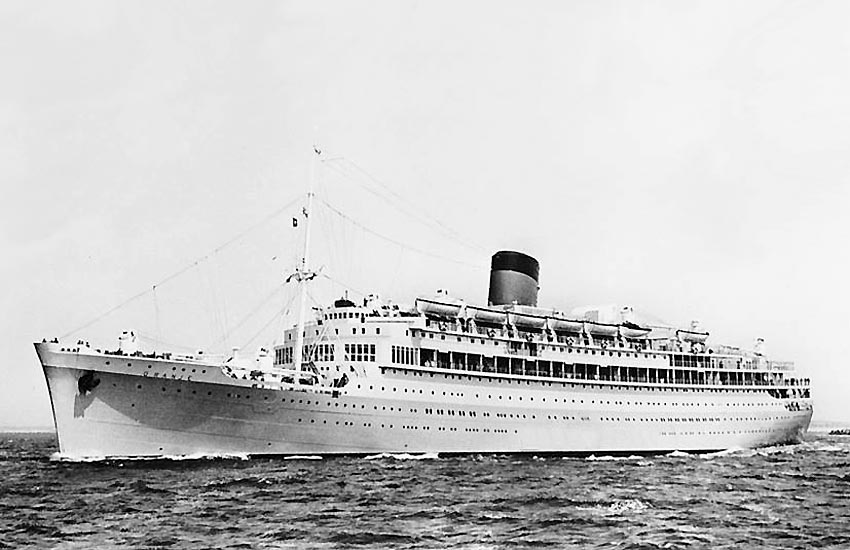
MS
Oranje is seen as built at full speed ahead
Postcard from
the author’s private collection
The Walter
von Stockhausen Story
From Stowaway to Naval Cadet
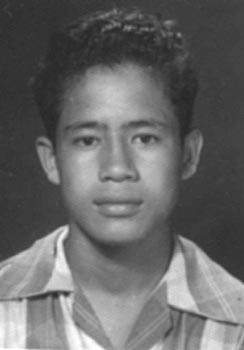
This
is the 15 year old Walter’s Passport photo and thus taken prior
to his great adventure on the
MS Oranje to the Netherlands!
Please Note: Photographs were
provided by Walter von
Stockhausen, unless stated otherwise
Ships Operating on the Dutch East Indies Service:
Two
major great Dutch Shipping Companies had for countless years operated their ships
almost exclusively on the “Dutch East Indies”
service. The first of being the “Nederlandsche Stoomvaart Maatschapij,” or “Netherlands Line” (NL), including their two fine liners, the; MS
Johan van Oldenbarnevelt
and the MS Oranje.
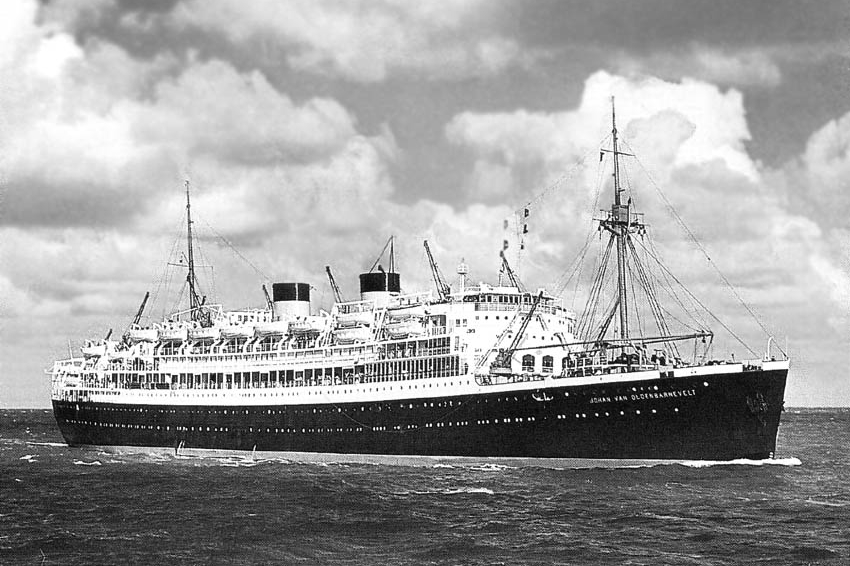
MS
Johan van Oldenbarnevelt in in her 1950s livery with
a black hull, but soon she would be extensively be modernised
Photograph from
the author’s private collection
The second company was
the famed “Koninklijke Rotterdamsche Lloyd” or
“Royal Rotterdam Lloyd” (RL) and this
company operated the; MS Sibajak and the MS Willem Ruys.
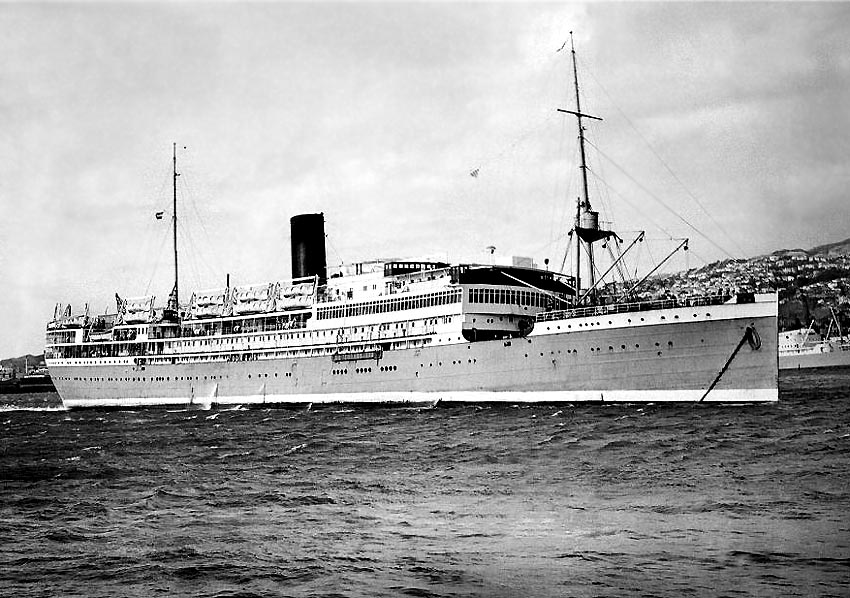
The
MS Sibajak, which the author of ssmaritime travelled on from
Rotterdam
to Wellington New Zealand
where she is seen in 1957
Photograph from
the author’s private collection
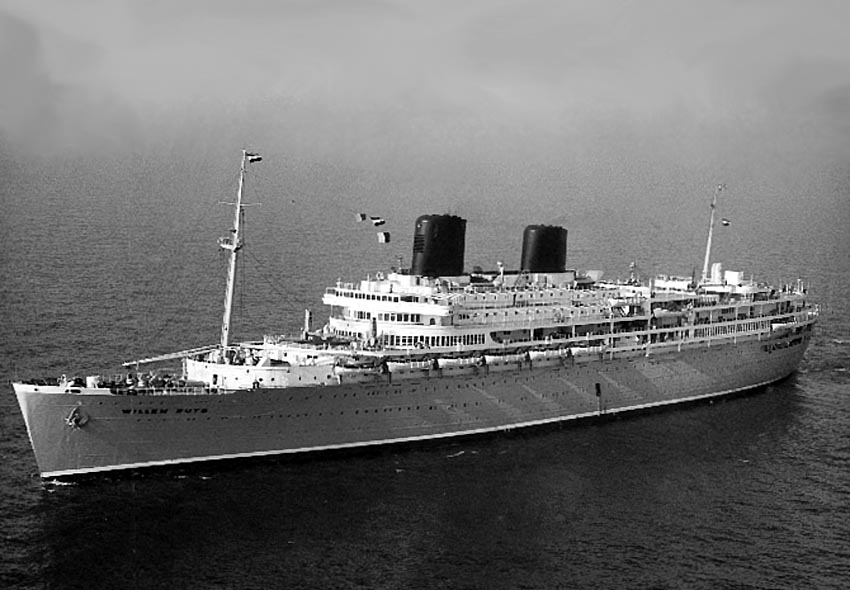
The
superbly modern and luxurious MS Willem Ruys
Postcard from
the author’s private collection
Below we will find Walter’s
remarkable story and we need to remember that he was just 15 years of age. Once
he is in the Netherlands
and in College, He concludes with Part Two covering the later years.
There is no doubt, but Walter did not have a great
start to his life, as he tells it: “From the age of 10 to 15, I was
placed in an orphanage of the Salvation Army by my Mother because she was
raising 9 children by herself, as after the war when my father did not return
it was just too much for her!”
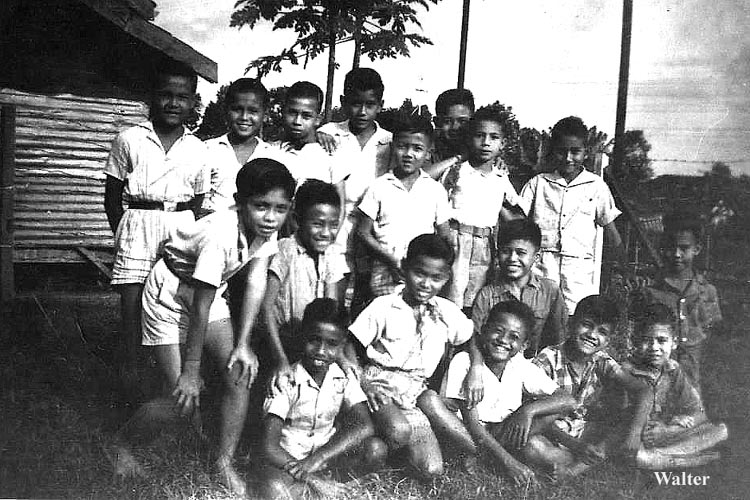
Walter
with other children at the orphanage grounds - he is seated on the far right
Walter’s Story – Part One:
“During the two years
of 1957 and 1958 there was a major migration of Dutch Indonesians who travelled
from Indonesia
to the Netherlands
on any of the Dutch liners that continues to call on what was now known as Indonesia.
The major cause for this was the worsening
political climate for the Dutch and also for the Dutch Indonesians living in
Indonesia primarily orchestrated by the Indonesia’s first president
Sukarno who felt that the Dutch still had political power in Indonesia, even
after the turnover of sovereignty to the Indonesians, but the Dutch insisted on
keeping West Papua where the exploration of its resources were still being done
by Dutch companies like BPM, Shell, Banka-Billiton, etc. Sukarno nationalized
all these companies, closed Dutch language schools and commenced to intimidate
Dutch Indonesians who did not choose to become an official Indonesian by
Naturalisation. Although, many did so but only out of fear and thinking this
would improve their living conditions but sadly it did not and they later
greatly regretted that decision.
Pressure from the Dutch government was
also exerted on the Dutch Indonesians to minimize their migration into the
Netherlands as it would hamper the Dutch own rebuilding efforts after World War
Two in terms of housing, schools, transportation and medical services. Without
a Dutch passport, Dutch Indonesians were not eligible for free repatriation to
the Netherlands. As
a result, there were those who decided to become stowaways on ships bound for
the Netherlands.
Needless to say stowaways to the Netherlands
certainly peaked during those years.
Amazingly, this clandestine method of
travelling to the Netherlands
from Indonesia
was not new, because myself and a just few others were considered to be the
trailblazers of this phenomenon!
I consider myself to be one of those first
stowaways when in December 1953; I decided to hide myself aboard of the MS
Oranje as she was bound for Amsterdam.
Even though I had a Dutch passport and was fully eligible for free passage to
the Netherlands, I decided to be a stowaway considering the situation in 1953
for Dutch Indonesians was not that bad as yet and my mothers and brothers and
sisters had not made the decision to leave as yet.
My decision was solely based on my desire to
continue my Dutch education. At that time Dutch language schools in Indonesia
had turned into expensive private schools and my mother with her meagre
widow’s pension simply could not afford my tuition and thus I was
transferred to a lower level secondary school which cost less. Being sixteen at
the time, I attended the second grade at the secondary school but I was too old
to be in that grade, but this was because I entered the school system aged 10
as a result of WWII as well as the Indonesian Revolutionary war. We all entered
what was known as a “crash primary school system” and despite all
my previous setbacks; I was able to pass the entrance exam for the Lyceum
(college), a preparatory university secondary school.
Three months before I had planned to travel as
a stowaway, two young men were caught trying to do the same and were sent back
to Jakarta, their port of
departure. But this did not deter me from trying to do it anyway. I knew I had
to prepare my plans with the greatest of care. I had to hide on the ship long
enough to pass through Indonesian territorial waters and, if I was caught, had
to have all the necessary documents. I made very sure I had my current Dutch
passport, my latest school report with good grades and a police affidavit of
good standing and no criminal record.
Through all the information that I had
acquired, I knew I had to stay hidden for at least four days until the ship was
outside Indonesian territorial waters so that they could not send me
back. I needed a floor plan of the ship which was available through a
local travel agency where a family friend was working as a clerk by the name of
Lodewijks. In order not to create suspicion of my
plan, I had to come up with the lie that I needed it for a show-and-tell
assignment at school. This trick had worked for me before when I requested a
free factory tour at the Wybert cough lozenges
factory in Bandung just to get a
free big box of the famous couch lozenges.
As a backup plan, I befriended a Dutch
Indonesian sergeant of the Dutch Military Mission transportation department who
was also leaving for the Netherlands
on the same ship. I asked him if he was willing to hide me in his
“hut” (cabin) onboard as soon as I got on the ship. He said yes,
probably thinking that there was no way I could possibly enter the ship.
From local newspapers ship arrival and
departure notices, I was able to determine the departure date of the ship. Thus
two days before, I was able to hitch a ride from Bandung to Jakarta
on a transport truck owned by the company where my older brother was working.
In Jakarta a worker of
the same company who worked at the harbour was able to get me a pass to get to
visit the ship. Then on the day of departure, there was a large crowd of people
with all kind of luggage ready to board. I had nothing on me except for what I
had on. Thus, in order not to attract any attention to myself, I offered to
assist an old lady, who happened to be an acquaintance of my mother. Her name
was mevrouw Schaverbeek.
She gladly accepted my help and thus I simply walked onto the ship carrying her
luggage, just as if I was one of the paying passengers.
Based on what I memorized from the
ship’s plan, I was able to find a hiding place where I had intended to
hide for the next four days. But I found out that as soon as the ship was in
open waters, it was easy to pretend that I was one of the passengers and joined
groups of young people during the daytime hours. But yet, I did not completely
feel secure. Luckily, I was able to locate the sergeant who was, of course,
surprised to see me but he kept his promise and hid me for a few days in his
cabin and I slept under his bed. He also fed me. On the fourth day,
he told me that we passed the last Indonesian port
of Belawan
and he made me promise that I never divulge his name, no matter what.
He made sure that nobody was in the hallway
when I slipped out his cabin. I asked the first crewmember I met in the
hallway for the way to the Captain’s cabin. I was surprised by the
laconic reaction of Captain Lasche, possibly because
I had all the required documents with me. I will never forget his name. He
called the Chief Boatswain and I was assigned to his crew of deckhands. Never
having done any kind of manual labour, I found the physical work very hard. The
crew accepted me right away as one of them. However, the head purser was not as
easy, for he kept on demanding who helped me on board and subjected me to stern
interrogation. However, as promised to the sergeant, I kept my mouth shut.
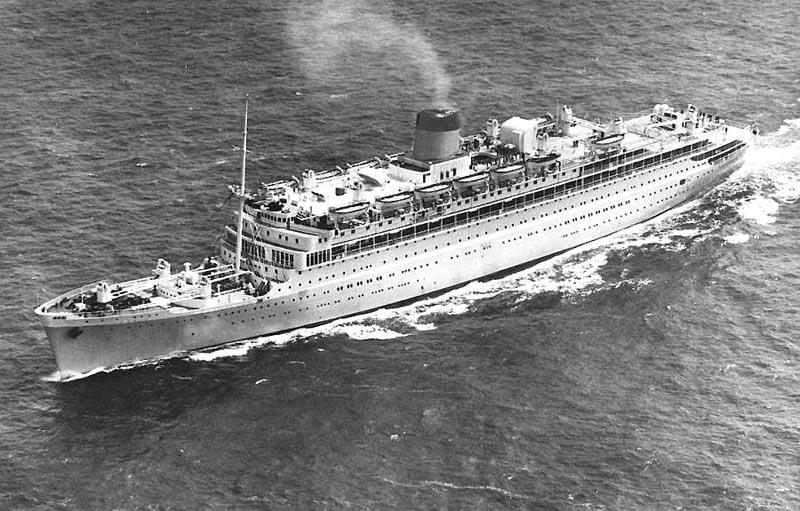
The
MS Oranje seen at sea bound for Amsterdam
Postcard from
the author’s private collection
I saw this sergeant, who hid me
in his cabin just one more time when we arrived in Amsterdam
when I was in the ship’s dining room, for I was being interrogated
by the Dutch immigration police. He appeared for a brief moment at the door and
threw a neutral glance at me as if he wanted to remind me of our agreement. I
winked at him indicating everything was OK. I understood his concern, being in
the military and having been involved in an illegal act. And, up to today, 60
years later, I have never been able to locate this sergeant. I cannot even
recall his name and possibly erased it from my sub consciousness out of fear
that I would divulge it at an interrogation. The only thing I can remember is
that he was a transportation officer in the motor pool of the NMM (Netherlands
Military Mission) in 1953 on the Riouw straat in Bandung.
His last residence was close to the “Vijfsprong”
in Bandung, in the
vicinity of the tank brigade camp. His young wife was of Menadonese
descent and was expecting a baby in 1954. She was 2-3 months pregnant while on
board because I had to endure her constant throwing up in the cramped cabin.
His military destination was Brabant in South Netherlands. He may
have stayed in the Netherlands
or immigrated to the US,
Canada
or Australia.
I hope one of his children or family member reads this and recognizes the
story. But I am afraid that he might have kept it a secret.”
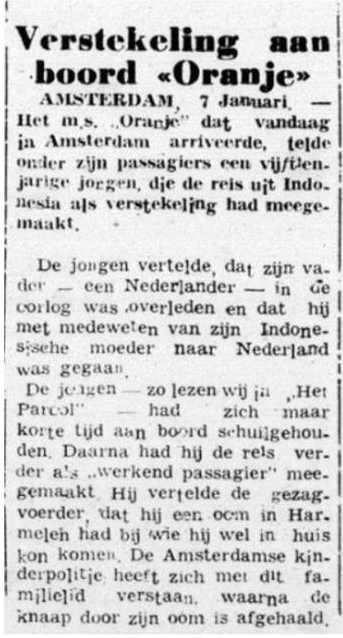
A
News report from the “Java-Bode” on January 16, 1954
“Java-Bode” Translation:
Stowaway On Board
“Oranje”
“The MS Orange
that arrived in Amsterdam today, with its passengers there was a fifteen year
old boy who experienced the trip from Indonesia as stowaway.
The boy told that his father who was a
Dutchman but during WWII was killed but with the knowledge of his mother he
went to the Netherlands.
The boy, we read in “The Parool” was hidden for just a short time on board.
Thereafter he continued the voyage as a working "passenger." He told
the Captain, that he had an uncle in Harmeleen and
that he could live in his house. The Amsterdam Youth Police had been in contact
with his family and the young boy was soon collected by his uncle and taken
home.”
“Once I was taken from the Oranje, I was
transferred to the Police Station on the Overtoom in Amsterdam
where my uncle, who was notified of my arrival, collected me. I stayed six
months at my uncle’s place in Maurik where he
registered me at the HBS (High school) in the town of Tiel.
I really did get along very well with my uncle and he admired my guts and
determination to travel as a stowaway just in order to continue my education.
He seemed to enjoy tutoring me in maths and geometry because those were the
tools of his profession when he worked for the former “Dutch Indies
Topographical Service.”
But sadly, late that spring my uncle died of a
heart attack. My relationship with my aunt was never that good; it could have
been that she was jealous that my uncle and I spent so much time together with
me. One late afternoon, it came to a point when she pushed me in anger against
a burning stove. Therefore, that same evening I left the house and rode on my
bicycle to Tiel with my suitcase on the back the
bicycle. However, along the road, I met my math teacher who was wondering where
I was going so late in the day with a suitcase on my luggage rack. I explained
to him the situation. He did not say much except for wishing me good luck. When
he got home, he called the Tiel Police who searched
for me. It was not until the next morning that they located me and I was
transported to the Orphanage Neerbosch close to the
town of Nijmegen. They could
do that because I was still a minor. I was thinking, to myself
“again?” because from the age of 10 to 15, I was placed in an
orphanage of the Salvation Army by my mother because raising 9 children by herself after the war when my father did not return was just
too much.
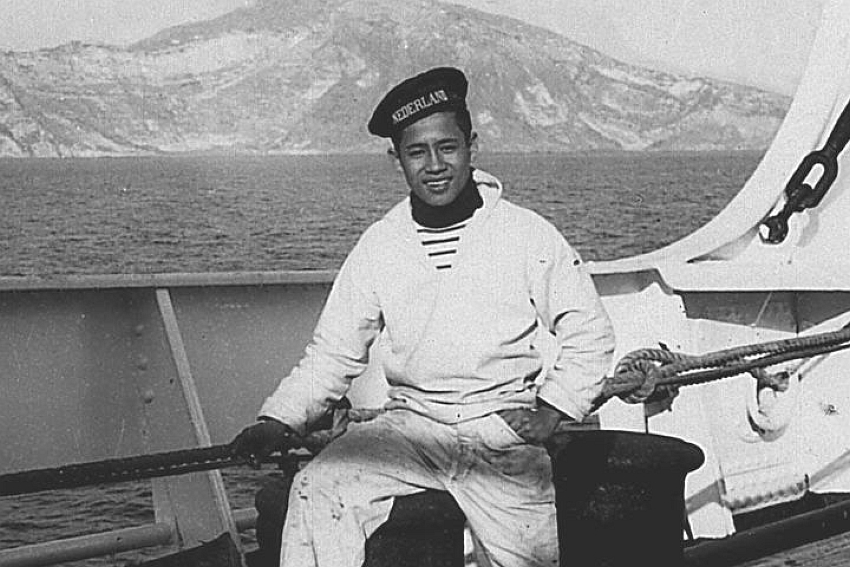
Here
we see Walter von Stockhausen later when he had become a Naval Cadet with his
adventure having become
a success
during times when there could have been a great deal of hardship, for
Sukarno’s days become full of turmoil!
At the orphanage,
they decided my profession for me. They placed me in the print shop to
become an apprentice printer. I have nothing against the profession of printer.
But that was not my choice; I wanted to continue my secondary education. So I
had the audacity to write to the Ministry of Social Services in The Hague and explained my situation of why I
had risked so much to come to the Netherlands
to continue my Dutch secondary education. That month, a social worker from
Arnhem, Ms. Ficke, visited me and arranged for me to move to
a Boarding School in Harderwijk to finish my
secondary education under the condition that I maintain a B plus grade average.
That summer, she arranged for a math tutor, my weakest subject.
In late summer I rode my bike with my
belongings on a long scenic trip to Harderwijk. Through the Betuwe, along the Rhine river and Utrechtse
Heuvelrug into the Hoge Veluwe and down to the lowlands of the IJselmeer.
During my trip, I noticed many estates with Indonesian names on it, indicating
their connection to Indonesia.
So this is how they got rich, from the Indonesian oil, tin, palm oil, rubber,
teak wood, etc.
I was able to finish the Lyceum level
secondary education at the boarding school.
During the great influx of Dutch Indonesians
in 1957-1958, I took part o a Dutch Radio program. Entitled; “BOEKA
PINTOE” meaning, “Open Your Doors”, and it
generated goodwill for the new arrivals of Dutch Indonesian’s to the Netherlands.
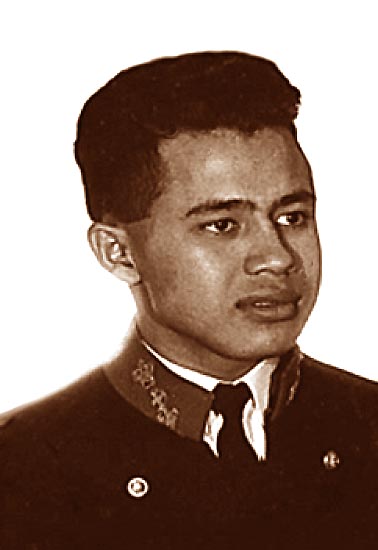
Mariner
von Stochausen seen during his days at the Royal Dutch Naval Academy in Den Helder
After my final exit exam of the
Lyceum, I applied for admission to the Royal Dutch Naval Academy in Den Helder.
There were 1,000 applicants and only 80 were admitted. I took a huge risk in
order to acquire the education that I wanted. And, now looking back, I am
truly one of the lucky ones as I became a Naval Cadet!”
Walter’s Story – Part Two:
“However, due to circumstances I did not
end up continuing a marine career once I completed the Naval
Academy.
This was mostly due because when we lost New Guinea thus there was no
opportunity for me to return to the Archipelago and I signed up for a course in
the Broadcast and Engineering School in Hilversum and I became a broadcast
engineer the rest of my life!
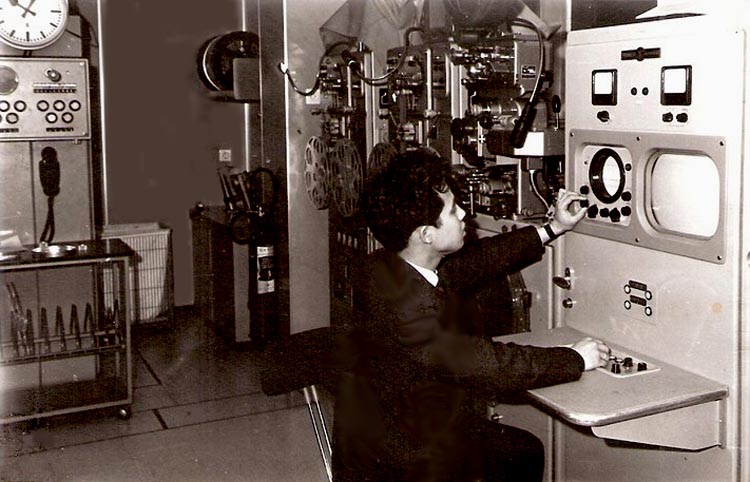
Walter
is seen as a Television Engineer for the NOS
I worked with the Dutch Radio and TV station
NOS, which had me working both indoors, but also as a cameraman in some
exciting places!”
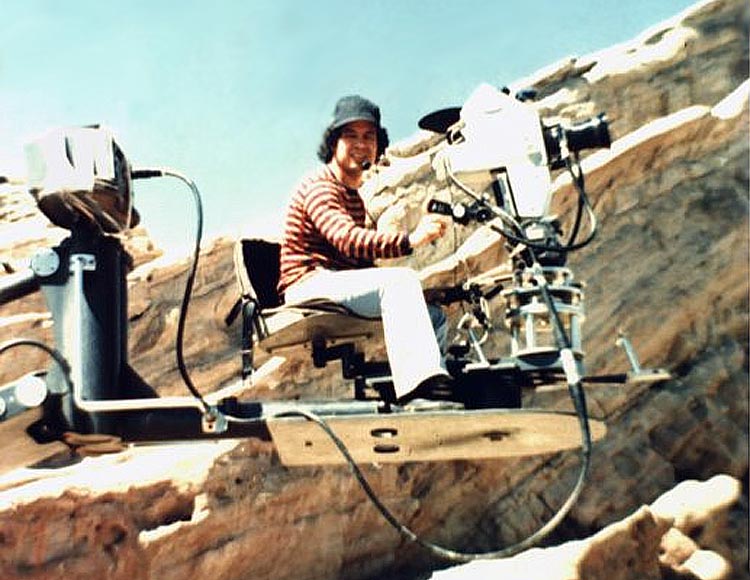
Here
we Walter as a TV cameraman, during his “Hollywood period“
Amazingly as Walter Ben von
Stockhausen’s life continued his stature grew along with his profession
to the point it even allowed him to return to Indonesia
for a several years, as he stated;
“The country I left as an illegal when I
was just 15 years old and amazingly I returned to Indonesia in 1983 as a
Semi-Diplomat as I was no an American AID Consultant for the US State
Department and was involved in the building of a TV studio for the Indonesian
Department of Education.”
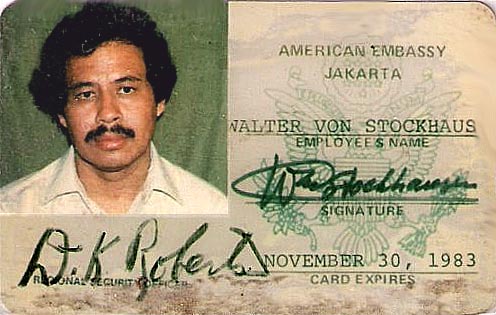
Walters’s
official American Embassy Jakarta ID
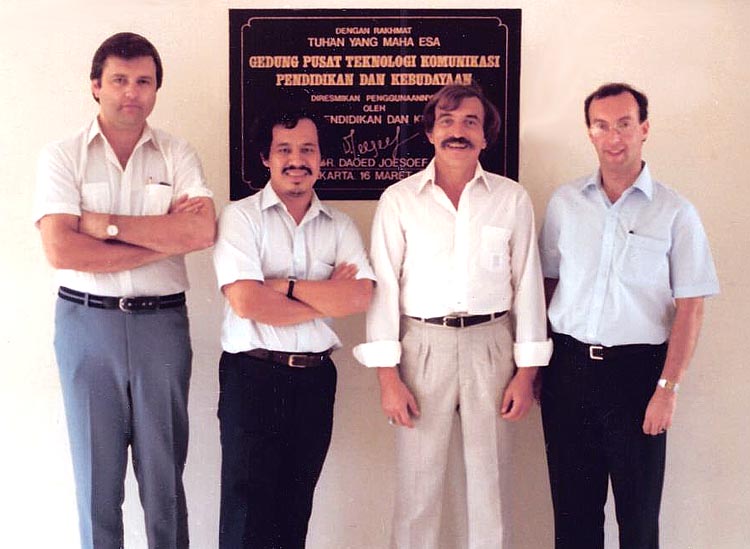
The
US-AID Team in Jakarta
In Conclusion:
I hereby wish to thank Walter von Stockhausen
for his kind assistance in delivering his remarkable story and his amazing
photographs. I believe that his story proves beyond doubt that when a young man
has a dream regarding making something of his life and has a desire for
education and was determined to make something of his life, he will do
everything in his power to get to achieve his goal! Walter certainly has done
that and I wish that the children of today would stop playing all those games
of death and destruction and get a good
and solid education and follow Walter’s lead, for he went all the way to
get there!
Reuben Goossens.
Maritime
Historian, Author & Lecturer.
Commenced
in the Passenger Shipping Industry in 1960.
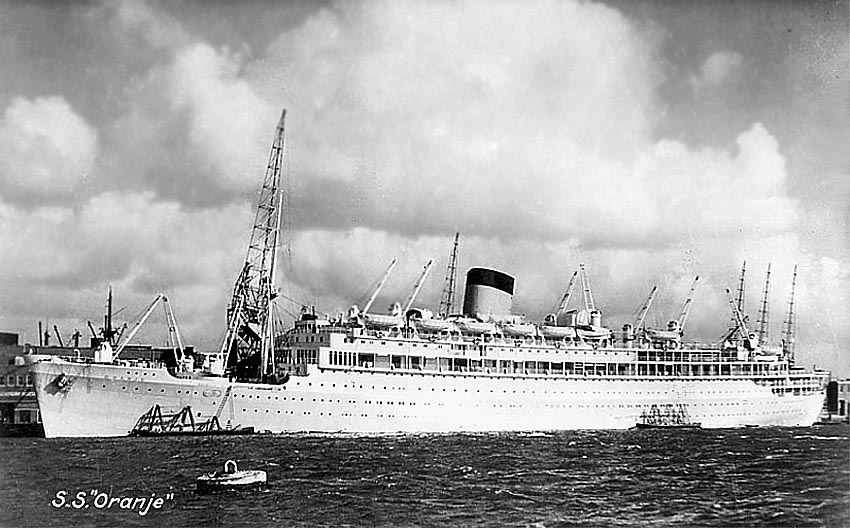
MS
Oranje seen berthed in Amsterdam
Postcard from
the author’s private collection
INDEX:
Page One: The Oranje Story
From shipyard, Wartime until her sale to Italy
in 1964.
Page
One b: MS Oranje
The Walter von Stockhausen Story - “From
Stowaway to Naval Cadet.”
Page
Two: The Angelina Lauro
Story Transformation
into an modern Italian liner.
Page
Three: Angelina Lauro Photo
Page
Page Four: Angelina Lauro’s demise
A Tragic Day on March 30, 1979.
Page
Five: Angelina Lauro Deck
Plan
Page
Six: MS Orange
Passenger list of her very first voyage/cruise 4 Aug 1939
Provided by
. passenger
Dieuwertje Goedkoop.
Note: This is the ONLY
List Have!
Visit
our Main Index for features on
other Dutch liners, such as the MS Johan van Oldenbarnevelt, Sibajak, Willem
Ruys (Achille Lauro), the TSS Rijndam
and her sister the TSS Maasdam, as well as the then Flagship of Holland America
Line, the grand SS Rotterdam and the magnificent SS Nieuw Amsterdam, as well as
the three simple migrant ships; the SS Waterman, Groote Beer and Zuiderkruis,
as well as the famous small, but the “Elegant White Yachts” of
Royal Interocean Lines as well as a number of other excellent Dutch
Passenger/Cargo ships. All of these can be found on my ssMaritime
Main Index below.
****************************************
Return
to the ssMaritime Main INDEX
ssMaritime.com & ssMaritime.net
Where
the ships of the past make history & the 1914 built MV Doulos Story
Please Note:
ssmaritime and associated sites are 100% non-commercial and the author seeks no funding or favours of any shape or form, never have
and never will!
Photographs
on ssmaritime and associate pages are by the author or from the author’s
private collection. In addition there are some images that have been provided
by Shipping Companies and private photographers or collectors. Credit is given
to all contributors. However, there are some photographs provided to me without
details regarding the photographer/owner concerned. I hereby invite if owners
of these images would be so kind to make them-selves known to me (my email
address may be found on www.ssmaritime.com only), in order that due credit may be
given.
This
notice covers all pages, although, and I have done my best to ensure that all
photographs are duly credited and that this notice is displaced on each page,
that is, when a page is updated!
ssMaritime is owned &
© Copyright by Reuben Goossens - All Rights Reserved















